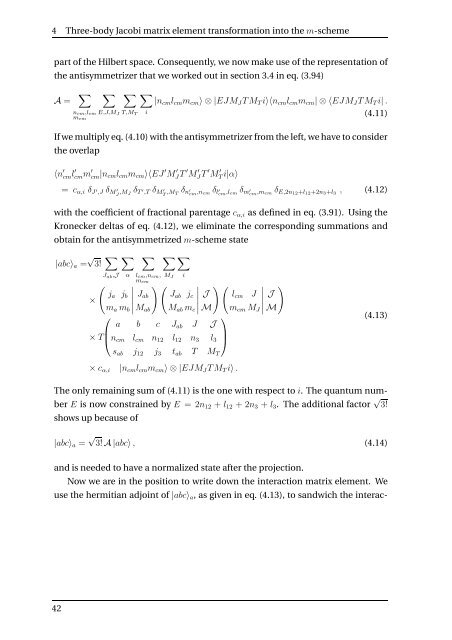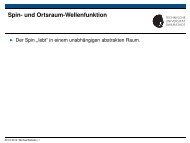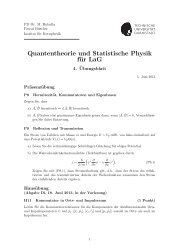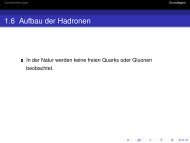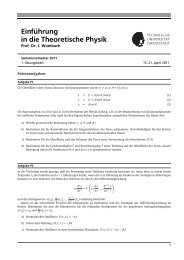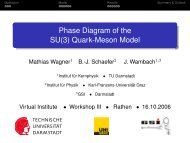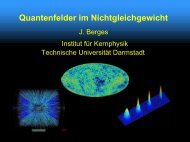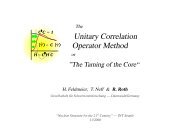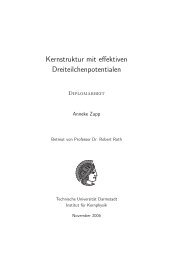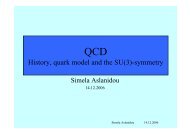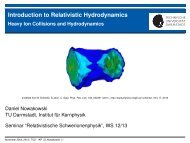Consistent chiral three-nucleon interactions in ... - Theory Center
Consistent chiral three-nucleon interactions in ... - Theory Center
Consistent chiral three-nucleon interactions in ... - Theory Center
Create successful ePaper yourself
Turn your PDF publications into a flip-book with our unique Google optimized e-Paper software.
4 Three-body Jacobi matrix element transformation <strong>in</strong>to the m-scheme<br />
part of the Hilbert space. Consequently, we now make use of the representation of<br />
the antisymmetrizer that we worked out <strong>in</strong> section 3.4 <strong>in</strong> eq. (3.94)<br />
A = <br />
ncm,lcm<br />
mcm<br />
<br />
E,J,MJ T,MT<br />
<br />
|ncmlcmmcm〉 ⊗ |EJMJTMTi〉〈ncmlcmmcm| ⊗ 〈EJMJTMTi| .<br />
i<br />
(4.11)<br />
If we multiply eq. (4.10) with the antisymmetrizer from the left, we have to consider<br />
the overlap<br />
〈n ′ cml ′ cmm ′ cm|ncmlcmmcm〉〈EJ ′ M ′ JT ′ M ′ JT ′ M ′ Ti|α〉<br />
= cα,i δJ ′ ,J δM ′ J ,MJ δT ′ ,T δM ′ T ,MT δn ′ cm,ncm δl ′ cm,lcm δm ′ cm,mcm δE,2n12+l12+2n3+l3 , (4.12)<br />
with the coefficient of fractional parentage cα,i as def<strong>in</strong>ed <strong>in</strong> eq. (3.91). Us<strong>in</strong>g the<br />
Kronecker deltas of eq. (4.12), we elim<strong>in</strong>ate the correspond<strong>in</strong>g summations and<br />
obta<strong>in</strong> for the antisymmetrized m-scheme state<br />
|abc〉a = √ 3! <br />
Jab,J<br />
α<br />
<br />
lcm,ncm, MJ<br />
mcm<br />
<br />
<br />
<br />
<br />
ja jb Jab Jab jc J<br />
× <br />
<br />
ma mb<br />
Mab Mab mc<br />
M<br />
⎛<br />
⎞<br />
a b c Jab J J<br />
⎜<br />
⎟<br />
× T⎝<br />
⎠<br />
ncm lcm n12 l12 n3 l3<br />
sab j12 j3 tab T MT<br />
× cα,i |ncmlcmmcm〉 ⊗ |EJMJTMTi〉 .<br />
i<br />
lcm J<br />
mcm MJ<br />
<br />
<br />
J<br />
<br />
M<br />
(4.13)<br />
The only rema<strong>in</strong><strong>in</strong>g sum of (4.11) is the one with respect to i. The quantum num-<br />
ber E is now constra<strong>in</strong>ed by E = 2n12 + l12 + 2n3 + l3. The additional factor √ 3!<br />
shows up because of<br />
|abc〉a = √ 3! A |abc〉 , (4.14)<br />
and is needed to have a normalized state after the projection.<br />
Now we are <strong>in</strong> the position to write down the <strong>in</strong>teraction matrix element. We<br />
use the hermitian adjo<strong>in</strong>t of |abc〉a, as given <strong>in</strong> eq. (4.13), to sandwich the <strong>in</strong>terac-<br />
42


